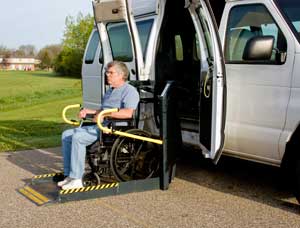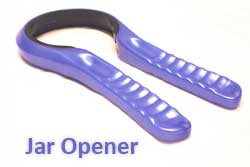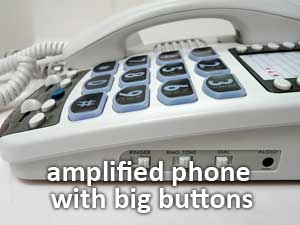 Fatigue (i.e., weariness caused by exertion) is an extremely
common problem with chronic disability. Fatigue can vary from a general state of lethargy to a work-induced burning sensation in certain muscles. It can be both physical and mental. Fatigue should not be ignored, as it can intensify the symptoms of
chronic disabilities, such as MS and fibromyalgia.
Fatigue (i.e., weariness caused by exertion) is an extremely
common problem with chronic disability. Fatigue can vary from a general state of lethargy to a work-induced burning sensation in certain muscles. It can be both physical and mental. Fatigue should not be ignored, as it can intensify the symptoms of
chronic disabilities, such as MS and fibromyalgia.
Self-care activities (e.g., toileting, bathing, grooming/hygiene activities, dressing, eating) can take considerable energy. Household chores or work tasks may need to be planned to include rest breaks and to balance daily demands with rest periods. Days with medical tests and appointments may be especially physically draining. For some, the demands of transport are very high and by the time they arrive for appointments, they are already fatigued. If it is not practical or possible to schedule regular rest periods during the day, it may be necessary to follow a day of activity with a day of rest.
As a caregiver, it is important to watch for signs of fatigue and support your loved one to rest when needed and to conserve energy to avoid fatigue. The energy conservation strategies listed below may be helpful.
Energy Conservation Guidelines

- Frequent, short rest periods between activities are more refreshing than fewer, longer ones.
- A balance of light, moderate and heavy work throughout the day and week is beneficial.
- A longer rest period in the early afternoon for about one hour helps to restore energy.
- Whenever possible, sit to work rather than stand.
- Use a good sitting posture and the best chair for your particular needs (e.g., a chair with arms may give better support for balance and stability). Have feet well-supported on the floor or a footstool.
- Plan ahead and have the required tools and supplies at hand to decrease walking.
- Eliminate unnecessary motions. For example, use an apron with pockets to carry small objects. Use a wheeled cart or chair to transport heavier items in one trip. Eliminate bending by placing the laundry basket within comfortable reach.
- Allow gravity to work for you. Slide items along rather than lifting them.
- Eliminate unnecessary steps or elements in routine life tasks. For example, make use of nutritious convenience foods (e.g., ready-to-cook, chopped fresh, frozen or canned vegetables). Let dishes drain on the dish rack rather than drying them by hand. Avoid ironing sheets, underwear and most other items.
- Arrange storage areas and work surfaces to be as efficient as possible and eliminate unnecessary steps, reaching and muscle strain. Work surfaces should be 2 – 3 inches (5 – 7 cm) below elbow level when seated. Store items where they will be used. Arrange items so that they may be removed without having to lift other items first. Heavy or frequently-used items should be stored at or just above counter height.
- Plan your schedule with flexibility in it so that you can rest before you are overtired. Allow enough time for rest, exercise and fun.
- Delegate your most difficult tasks to others. Eliminate unnecessary jobs entirely.
Source: Adapted from Glenrose Rehabilitation Hospital, rheumatoid arthritis educational materials.
 Muscle strength can be reduced during prolonged illness or as a result
of immobilization. Individuals with arthritis may find it difficult to hold a pen or pencil, turn knobs or open jars. In some instances, the chronic disability may interrupt the communication between the brain and the muscles. Pain may also play a
role in muscle weakness. If increased weakness is a part of the chronic disability, assistive devices and gadgets (e.g., easy-grip kitchen tools) can help maintain independence.
Muscle strength can be reduced during prolonged illness or as a result
of immobilization. Individuals with arthritis may find it difficult to hold a pen or pencil, turn knobs or open jars. In some instances, the chronic disability may interrupt the communication between the brain and the muscles. Pain may also play a
role in muscle weakness. If increased weakness is a part of the chronic disability, assistive devices and gadgets (e.g., easy-grip kitchen tools) can help maintain independence.
Some people have difficulty gripping door knobs, but find a lever-style of door handle much easier to open. People with limited strength may also find it difficult to hold a telephone receiver for the duration of a phone call. Speaker phones may work better for these individuals.
Coordination is the control of muscles to accomplish a movement accurately, efficiently and repeatedly. It has more to do with the quality of the movement a person can produce, whereas strength is associated with the quantity of movement. Coordination also involves how well the limbs and both sides of the body work together. Coordination challenges can occur at the gross motor level (e.g., walking and reaching) or at the fine motor level (e.g., tying shoelaces). Some strategies for overcoming coordination challenges are provided below.
Velcro closures on running shoes and slip-on shoes are simple substitutes for shoes with laces.
 Cell phones and home phones
with small keypads are difficult for people with poor fine motor control to use. Similarly, remote controls for televisions and other electronics have become increasingly more difficult to use as more little buttons are placed close together to fit
more functions in a limited space. However, phones with large buttons are available. It is possible to buy a remote control with as few as six buttons (i.e., power, volume-up, volume-down, channel-up, channel-down and mute), which are easier to use
with limited coordination (as well as visual or cognitive impairments).
Cell phones and home phones
with small keypads are difficult for people with poor fine motor control to use. Similarly, remote controls for televisions and other electronics have become increasingly more difficult to use as more little buttons are placed close together to fit
more functions in a limited space. However, phones with large buttons are available. It is possible to buy a remote control with as few as six buttons (i.e., power, volume-up, volume-down, channel-up, channel-down and mute), which are easier to use
with limited coordination (as well as visual or cognitive impairments).
Individuals with coordination problems may have difficulty picking up and holding the receiver of a telephone. A speaker phone may resolve this difficulty, provided the speaker button is easy to find and press. Another option is a headset or bluetooth device.
Individuals with poor fine motor control may also benefit from large-format controls for light switches, or appliances that operate by making a specific sound, such as clapping.
Computers - whether desktops, notebooks, tablets or smart phones - are an important part of most people’s lives. Operating systems in these devices all have settings to improve their accessibility for people with various disabilities. To learn more about the accessibility features of various operating systems, visit the following websites:
- Windows—https://www.microsoft.com/en-us/accessibility
- Apple products—https://www.apple.com/ca/accessibility
- Android products—https://support.google.com/accessibility/android
 Both strength and coordination may be affected by spasticity
or a change in muscle tone. They may cause a person’s muscles to fail to contract efficiently, or to tighten too much and not relax easily on demand. Spasms result when a muscle tightens, even though the person did not intend it to do so.
Both strength and coordination may be affected by spasticity
or a change in muscle tone. They may cause a person’s muscles to fail to contract efficiently, or to tighten too much and not relax easily on demand. Spasms result when a muscle tightens, even though the person did not intend it to do so.
Cerebral palsy is an example of a chronic disability in which tone and spasticity affect coordination. In addition to their impact on movement, spasms and uncontrollably tight muscles can cause significant pain. This can disrupt a person’s daily functioning and affect the quality and quantity of sleep, which is another factor in maintaining physical health. Muscular dystrophy, dystonia, multiple sclerosis, ALS and Parkinson’s disease are other conditions that cause the messages between the brain and the muscles to be interrupted or distorted.
Spasticity can often be managed with medication. The Spasticity Program for Adults at the Glenrose Rehabilitation Hospital is a specialized clinic that can assess how best to manage tone changes, spasms and spasticity.
Tremors are shaking movements that may be present when the person is resting or moving about. The type of tremor depends on the diagnosis (e.g., Parkinson’s disease). Tremor often occurs in the limbs, but can also be present in the neck muscles, which produces head movement.
Treatment is individual. What works to manage tremor in one person may not work for another, so trial and error is common in trying to find a solution.
 In addition to the assistive devices discussed in connection with
strength and coordination limitations, individuals with muscle tone and spasticity issues may find ability switches a useful way to control mechanical and electronic devices. These switches come in different sizes and can be activated in different
ways; for example, an ability switch can be a large button that is pressed, or a tube that is operated by blowing into it.
In addition to the assistive devices discussed in connection with
strength and coordination limitations, individuals with muscle tone and spasticity issues may find ability switches a useful way to control mechanical and electronic devices. These switches come in different sizes and can be activated in different
ways; for example, an ability switch can be a large button that is pressed, or a tube that is operated by blowing into it.
 Mobility pertains to how individuals get around
in their environment. It may be affected by changes in muscle strength, tone, spasticity or coordination. If your loved one’s walking skills have declined, a mobility aid, such as a walker, cane, or a manual or powered wheelchair may be needed. People
need time to get used to using mobility aids, both physically and psychologically. It’s important to practise using the device at home and in other places that the person frequents.
Mobility pertains to how individuals get around
in their environment. It may be affected by changes in muscle strength, tone, spasticity or coordination. If your loved one’s walking skills have declined, a mobility aid, such as a walker, cane, or a manual or powered wheelchair may be needed. People
need time to get used to using mobility aids, both physically and psychologically. It’s important to practise using the device at home and in other places that the person frequents.
Keep the mobility aid within reach of your loved one. If necessary, rearrange furniture to ensure that the aid is readily available and in plain sight. These measures promote routine use, especially for individuals who have not yet accepted their need for support in walking, as they may “forget” to use the device, risking falls and injury due to instability. Memory or judgement problems may also complicate the routine use of mobility aids by leading individuals to believe that they can safely move around the house without their mobility aid.
Minimize hazards and risk of falls. Short of constant vigilance (or constant nagging), rooms should be arranged to eliminate tripping and slipping hazards (e.g., no magazines on the floor), furniture should be able to take the person’s weight without tipping (if grabbed for support) and walls should be accessible to guide the person to their destination. Install grab bars in bathrooms, hallways and other locations to support individuals with mobility, coordination and similar concerns.
Rushing to the phone when it rings can lead to falls and injury. Placing a cell phone or cordless phone beside the individual can prevent this problem. However, if the person moves around the home without the phone, this solution is ineffective. This problem can be solved in a number of ways, such as a holster for the phone that attaches to the wheelchair or walker, or simply wearing clothes with pockets and keeping the phone in the pocket when not in use.
Turning on a light or fan can be made easier and safer by plugging it into an X-10 module, then plugging the module into the wall. Individuals can then use a transmitter to turn the appliance on or off from wherever they are. X-10 modules are available from stores like The Source and also on the Internet.
Similar assistive devices for operating lights and small appliances are ability switches and “the clapper.”
When the individual is at home alone, safety is a particularly important issue. Individuals with mobility issues may fall and be unable to get to a phone to call for help. Home monitoring services are one type of support that can be used to address safety issues.
Click to view some examples of home monitoring services in the Edmonton area.
 Individuals with a fragile medical status are particularly
sensitive to bacteria, viruses and other microbes, and exposure can cause their weakened immune systems to collapse. They may be more susceptible to health challenges when fatigued by medical appointments and transportation issues.
Individuals with a fragile medical status are particularly
sensitive to bacteria, viruses and other microbes, and exposure can cause their weakened immune systems to collapse. They may be more susceptible to health challenges when fatigued by medical appointments and transportation issues.
Surgical masks, available from medical supply companies, and frequent use of hand sanitizers by the loved one, caregiver and others, help to reduce exposure. Surfaces should be disinfected often. Towels, washcloths and dishcloths should be changed frequently.